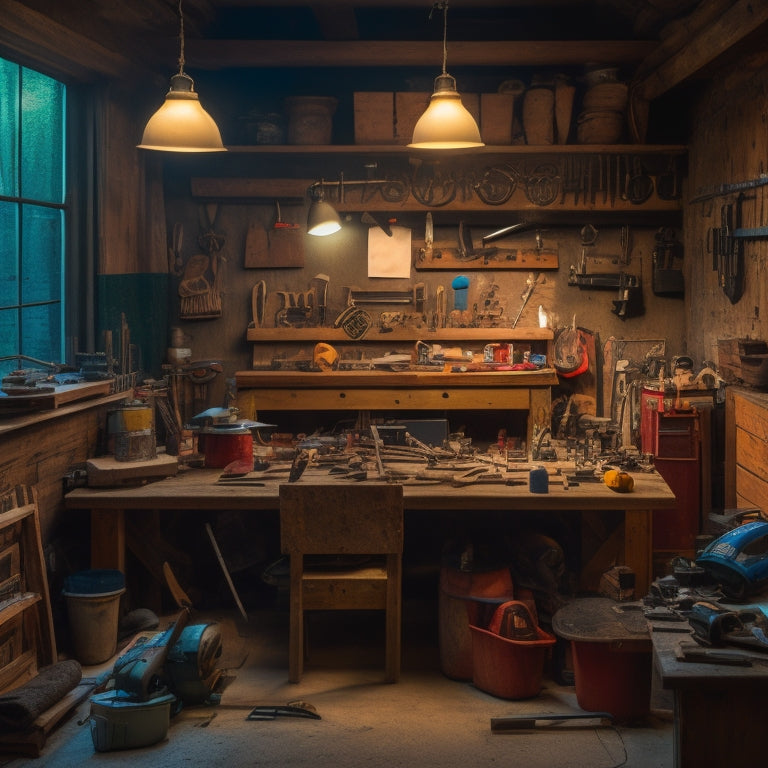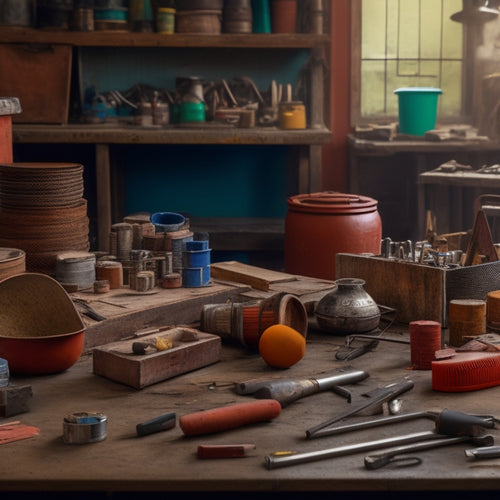
Best Power Tools for Home Renovation Success
Share
You're about to tackle a home renovation project that will transform your living space, but without the right power tools, you'll be stuck in DIY limbo. Invest in essential drilling and fastening tools like cordless drills, impact drivers, and the right fasteners for the job. Reliable sawing and cutting machines, such as circular saws and jigsaws, will streamline your workflow. Don't forget heavy-duty demolition and removal tools, versatile sanding and finishing tools, and critical mixing and application equipment. With the right tools, you'll be confident in tackling any renovation task - and that's just the starting point for your project's success.
Key Takeaways
• Invest in a diverse set of drills, including cordless, hammer, and impact drills, to tackle various renovation tasks efficiently.
• Select the right fasteners, such as screws, nails, and bolts, and master proper fastening techniques to ensure project success.
• Equip yourself with reliable sawing machines, including circular, jigsaw, and table saws, to make accurate cuts and minimize material waste.
• Don't underestimate the importance of safety equipment, such as safety goggles and dust masks, when working with demolition and removal tools.
• A good set of measuring devices, including laser levels and measuring tapes, is crucial for accurate measurements and precise alignments in renovation projects.
Essential Drilling and Fastening Tools
You'll need a reliable drill and a set of durable fasteners to tackle most home renovation tasks, so investing in high-quality crucial drilling and fastening tools is a must. With the right drill types and fastening techniques, you'll be able to complete projects efficiently and effectively.
There are several drill types to evaluate, including cordless, hammer, and impact drills, each suited to specific tasks and materials. Cordless drills offer convenience and portability, while hammer drills are ideal for masonry and concrete work. Impact drills provide high torque for heavy-duty applications.
When it comes to fastening techniques, it's important to choose the right fasteners for the job. From screws and nails to bolts and anchors, each type of fastener has its own unique strengths and weaknesses. Understanding the differences will help you select the best fastening solution for your project.
Reliable Sawing and Cutting Machines
When tackling home renovation projects, a reliable set of sawing and cutting machines is essential for making precise cuts and shaping materials efficiently. You'll need a variety of saws to tackle different tasks, and investing in the right ones will save you time and frustration.
For straight cuts, consider circular saws or track saws, which offer precision and ease of use. For curved cuts, jigsaw options or band saws are ideal. Table saws are perfect for ripping large sheets of material, while reciprocating saws excel at demo work and rough cuts. Miter saws are a must-have for precise angled cuts, and scroll saws are great for intricate curves.
Having these saws in your arsenal will guarantee you're equipped to tackle any project that comes your way. Don't settle for low-quality saws that can lead to inaccurate cuts and wasted materials. Invest in reliable, high-quality sawing and cutting machines to take your home renovation projects to the next level.
Must-Have Measuring and Testing Devices
Accurate measurements and precise testing are essential to the success of your home renovation project, and having the right devices on hand can mean the difference between a professional-looking finish and a DIY disaster.
You'll need reliable measuring tapes that can withstand the rigors of daily use and provide accurate readings. Look for tapes with durable casings, clear markings, and sturdy hooks that can hold their own against rough surfaces.
For more complex projects, consider investing in laser levels that can help you achieve precise alignments and leveling. These devices are especially useful for installing cabinets, shelves, and flooring. With a laser level, you can guarantee that your surfaces are perfectly level, plumb, and square, saving you time and frustration in the long run.
Additionally, don't forget to pick up a digital multimeter to test electrical currents, voltage, and resistance. This handy tool will give you peace of mind when working with electrical systems.
Heavy-Duty Demolition and Removal Tools
Tearing down old structures and removing unwanted materials is an essential step in your home renovation project, and that's where heavy-duty demolition and removal tools come in.
You'll need these powerful tools to break through concrete, brick, or asphalt, and to demolish walls, floors, and ceilings.
Demolition hammers are a must-have for any serious renovation project. They're designed to deliver high-impact blows, making quick work of even the toughest materials.
For more precise demolition work, consider a rotary hammer or a concrete breaker. These tools provide more control and are ideal for smaller areas or more delicate demolition tasks.
Don't forget to invest in a good pair of safety goggles and a dust mask to protect yourself from flying debris and dust.
With the right heavy-duty demolition and removal tools, you'll be able to tackle even the most intimidating demolition tasks with confidence.
Versatile Sanding and Finishing Tools
When it comes to preparing surfaces for a flawless finish, you'll need the right sanding and finishing tools to get the job done efficiently.
You'll be amazed at how belt sanders can streamline your workflow, and rotary tools will become your new best friend for tackling intricate details.
Belt Sanders Unleashed
With a belt sander in hand, you're equipped to tackle a wide range of sanding and finishing tasks with ease, from smoothing out rough wood to removing old finishes. This powerful tool is a must-have for any home renovation project, and with the right techniques and maintenance, you'll get the most out of it.
Here are some key tips to keep in mind:
-
Master your belt sander techniques: Learn how to hold the sander correctly, move it in straight lines, and apply consistent pressure to avoid scratches and swirl marks.
-
Perform regular belt sander maintenance: Clean the sander regularly, check the belt for wear and tear, and replace it when necessary to maintain peak performance.
-
Choose the right sandpaper: Select the correct grit and type of sandpaper for your project to achieve the desired finish.
- Work in small sections: Divide your project into smaller areas to maintain control and avoid missing spots.
Rotary Tools Mastery
You'll discover that rotary tools, also known as rotary sanders or die grinders, are incredibly versatile sanding and finishing tools that can tackle a wide range of tasks, from precision sanding to detail work and polishing.
With the right rotary tool techniques, you'll be able to achieve professional-looking results in no time. Whether you're working with wood, metal, or drywall, these tools are perfect for removing rust, corrosion, or old finishes, and preparing surfaces for painting or staining.
To get the most out of your rotary tool, you'll want to invest in a variety of rotary tool accessories, such as sanding drums, grinding stones, and polishing wheels. These accessories will allow you to tackle specific tasks with ease and precision.
For example, a sanding drum is perfect for removing old finishes from curved surfaces, while a grinding stone is ideal for sharpening metal edges. By mastering rotary tool techniques and having the right accessories on hand, you'll be able to tackle even the most complex projects with confidence.
With practice and patience, you'll be amazed at what you can accomplish with these powerful tools.
Critical Mixing and Application Equipment
Your mixing and application equipment arsenal should include a powerful drill, equipped with a mixing paddle, to tackle thick compounds and adhesives. This will guarantee you can efficiently mix and apply materials like mortar, concrete, and epoxy.
Additionally, consider investing in specialized equipment to streamline your renovation process.
Here are some essential mixing and application tools to add to your collection:
-
Mortar mixers: Perfect for mixing and blending mortar, concrete, and stucco.
-
Paint sprayers: Ideal for applying paint, stain, and sealers to large surfaces quickly and evenly.
-
Grout mixers: Designed for mixing and applying grout to tile and stone surfaces.
- Caulk guns: Essential for applying caulk and adhesives to seal gaps and joints.
These tools will help you achieve professional-looking results and save time on your home renovation project.
Specialized Lifting and Holding Devices
When you're tackling a home renovation project, you'll likely encounter heavy materials or awkwardly shaped objects that need to be lifted or held in place.
That's where specialized lifting and holding devices come in, and you'll want to familiarize yourself with three key points:
-
Pulley systems for heavy loads,
-
Vacuum lifting technology for delicate surfaces,
-
Clamping systems for precision control.
Pulley Systems for Heaviness
One of the most critical components of any home renovation project involving heavy materials or equipment is a reliable pulley system, designed to safely lift and hold massive objects in place. You can't afford to compromise on the safety and efficiency of your project, and a good pulley system guarantees that. When it comes to pulley systems, you need to take into account a few essential factors to guarantee you're getting the most out of your investment.
Here are some key considerations to keep in mind:
-
Pulley weight distribution: Make certain the pulley system is designed to distribute weight evenly, reducing the risk of accidents and damage to your equipment.
-
Pulley maintenance tips: Regularly inspect and maintain your pulley system to confirm it's functioning at peak levels.
-
Material compatibility: Choose a pulley system that's compatible with the materials you're working with, whether it's wood, metal, or something else.
- Load capacity: Select a pulley system that can handle the weight of your heaviest materials or equipment.
Vacuum Lifting Technology
For heavy, flat, or delicate materials that can't be lifted with traditional pulleys, vacuum lifting technology offers a specialized solution, allowing you to securely grasp and maneuver items with ease. This innovative technology uses air pressure to create a vacuum seal, providing a strong and reliable hold on your materials. With vacuum lifting, you can lift and move heavy objects without straining your back or damaging the material.
Here are some examples of vacuum lifting benefits and innovative applications:
| Material | Weight Capacity | Common Uses |
|---|---|---|
| Glass | Up to 500 lbs | Installing glass countertops or shower doors |
| Stone | Up to 1,000 lbs | Laying stone flooring or installing granite countertops |
| Drywall | Up to 200 lbs | Hanging drywall for smooth finishes |
| Metal | Up to 500 lbs | Moving metal sheets for fabrication or installation |
| Delicate Art | Up to 50 lbs | Handling and installing fragile artwork or decorative pieces |
With vacuum lifting technology, you can tackle a wide range of projects with confidence, knowing that your materials are secure and under control. This specialized lifting solution is perfect for home renovation projects that require precision and care.
Clamping for Precision
Clamping for Precision
You'll achieve precise control and stability with clamping systems, which provide a secure grip on your workpieces, allowing you to focus on making accurate cuts, drillings, or assemblies. This is especially vital when working with delicate or irregularly shaped materials. With the right clamping system, you can guarantee that your workpieces remain stationary, reducing the risk of errors and improving overall quality.
When it comes to choosing the right clamping system, you'll want to take into account the following factors:
-
Clamp types: Bar clamps, pipe clamps, and F-style clamps are popular options, each suited for specific tasks and materials.
-
Clamp materials: Aluminum, steel, and nylon clamps offer varying degrees of strength, durability, and corrosion resistance.
-
Workpiece size and shape: Select clamps that can accommodate your workpiece's dimensions and irregularities.
- Pressure and force: Choose clamps that can apply the necessary pressure and force to hold your workpiece securely in place.
Frequently Asked Questions
Can I Use Power Tools in Areas With High Moisture Levels?
When working in areas with high moisture levels, you need to take extra precautions to guarantee your safety.
You can't just use any power tool in these conditions. Look for tools with moisture resistance or waterproofing to minimize the risk of electrical shock.
Even with these tools, you still need to take safety precautions, such as keeping them away from standing water and avoiding use in direct rain or snow.
How Often Should I Maintain and Clean My Power Tools?
You're the master of your domain, and your power tools are your trusted sidekicks.
But, just like a loyal companion, they need regular TLC to perform at their best.
Create a cleaning schedule to wipe away dirt and grime, and make tool maintenance tips a priority.
Set aside time each week to inspect and clean your tools, and you'll be rewarded with precision, efficiency, and a job well done.
Are Power Tools Suitable for Left-Handed Users?
You're wondering if power tools are suitable for left-handed users. The answer is yes!
Most power tool designs prioritize ergonomics, making them comfortable for both right- and left-handed users.
Look for tools with ambidextrous handles or reversible batteries, which cater to left-handed ergonomics.
You'll find that many manufacturers consider left-handed users in their power tool design, ensuring you can work efficiently and safely, regardless of your handedness.
Can I Share Power Tools With Friends or Family Members?
You're about to begin a power tool sharing extravaganza, lending your prized possessions to friends and family like they're going out of style!
But, hold on, don't let your generosity cloud your judgment. Remember, power tool safety is paramount, so make certain you're sharing with people who know what they're doing.
Establish some sharing etiquette, like setting clear boundaries and guidelines, to avoid any misunderstandings.
Do Power Tools Require Regular Calibration or Adjustments?
You're wise to wonder if your power tools need regular calibration or adjustments. The answer is yes, to guarantee power tool accuracy.
Over time, usage can affect their precision, leading to subpar results.
Familiarize yourself with calibration techniques specific to each tool, and perform checks regularly.
This simple habit will maintain your tools' performance, saving you time and frustration in the long run.
Conclusion
With these power tools in your arsenal, you're ready to tackle any home renovation project that comes your way.
You've got the precision of a surgeon, the strength of a beast, and the finesse of a master craftsman.
Your toolbox is now a treasure trove of possibilities, waiting to set free your inner DIY rockstar.
So, don your hard hat, fire up your tools, and let the transformation begin!
Related Posts
-

5 Must-Have Plastering Tools for Safe Renovation
You'll need a range of essential tools to tackle your plastering project safely. Invest in a variety of trowels, incl...
-

Streamline Your Exterior Renovation Timeline
To streamline your exterior renovation timeline, you'll need to approach the process strategically. Start by planning...
-

Budget-Friendly Materials for Your Home Renovation Needs
As you initiate your home renovation, you're enthusiastic to find budget-friendly materials that fit your vision with...


